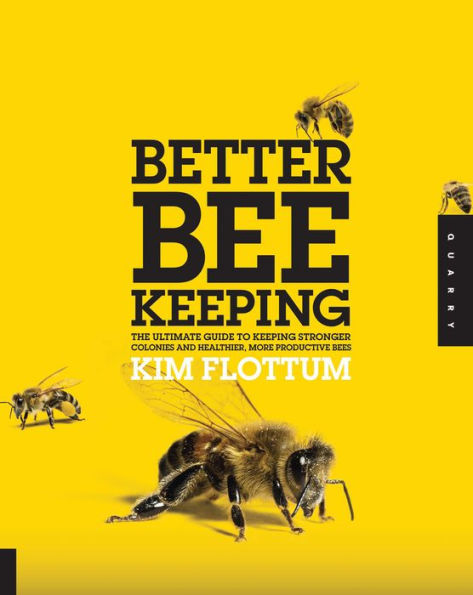Better Beekeeping: The Ultimate Guide to Keeping Stronger Colonies and Healthier, More Productive Bees
“The most lucid call to action ever written about land-based beekeeping” from the author of The Backyard Beekeeper (Tammy Horn, author of Bees in America and Beeconomy).
Backyard beekeepers everywhere agree: a successful colony is a thing of beauty.
Thousands of beekeepers have started beekeeping thanks to Kim Flottum’s first book, The Backyard Beekeeper, and they have added to their repertoire of skills with The Backyard Beekeeper’s Honey Handbook. Now, Better Beekeeping answers the question, “What do I do now that I’m a beekeeper?” This book takes serious beekeepers past the beginning stages and learning curves and offers solutions and rewards for keeping bees a better way. Better queens, better winters, better food, and better bees await any beekeeper willing to take on the challenge of having the right number of bees, of the right age, in the right place, in the right condition, at the right time.
“There are numerous beekeeping books on the shelves that instruct on ‘how to,’ but Better Beekeeping is a book that explores ‘why to,’ which is essential for this ever-changing world of beekeeping today.” —Jennifer Berry, research coordinator at the University of Georgia’s Honey Bee Research Lab, commercial queen, and columnist for Bee Culture magazine
1102249652
Backyard beekeepers everywhere agree: a successful colony is a thing of beauty.
Thousands of beekeepers have started beekeeping thanks to Kim Flottum’s first book, The Backyard Beekeeper, and they have added to their repertoire of skills with The Backyard Beekeeper’s Honey Handbook. Now, Better Beekeeping answers the question, “What do I do now that I’m a beekeeper?” This book takes serious beekeepers past the beginning stages and learning curves and offers solutions and rewards for keeping bees a better way. Better queens, better winters, better food, and better bees await any beekeeper willing to take on the challenge of having the right number of bees, of the right age, in the right place, in the right condition, at the right time.
“There are numerous beekeeping books on the shelves that instruct on ‘how to,’ but Better Beekeeping is a book that explores ‘why to,’ which is essential for this ever-changing world of beekeeping today.” —Jennifer Berry, research coordinator at the University of Georgia’s Honey Bee Research Lab, commercial queen, and columnist for Bee Culture magazine
Better Beekeeping: The Ultimate Guide to Keeping Stronger Colonies and Healthier, More Productive Bees
“The most lucid call to action ever written about land-based beekeeping” from the author of The Backyard Beekeeper (Tammy Horn, author of Bees in America and Beeconomy).
Backyard beekeepers everywhere agree: a successful colony is a thing of beauty.
Thousands of beekeepers have started beekeeping thanks to Kim Flottum’s first book, The Backyard Beekeeper, and they have added to their repertoire of skills with The Backyard Beekeeper’s Honey Handbook. Now, Better Beekeeping answers the question, “What do I do now that I’m a beekeeper?” This book takes serious beekeepers past the beginning stages and learning curves and offers solutions and rewards for keeping bees a better way. Better queens, better winters, better food, and better bees await any beekeeper willing to take on the challenge of having the right number of bees, of the right age, in the right place, in the right condition, at the right time.
“There are numerous beekeeping books on the shelves that instruct on ‘how to,’ but Better Beekeeping is a book that explores ‘why to,’ which is essential for this ever-changing world of beekeeping today.” —Jennifer Berry, research coordinator at the University of Georgia’s Honey Bee Research Lab, commercial queen, and columnist for Bee Culture magazine
Backyard beekeepers everywhere agree: a successful colony is a thing of beauty.
Thousands of beekeepers have started beekeeping thanks to Kim Flottum’s first book, The Backyard Beekeeper, and they have added to their repertoire of skills with The Backyard Beekeeper’s Honey Handbook. Now, Better Beekeeping answers the question, “What do I do now that I’m a beekeeper?” This book takes serious beekeepers past the beginning stages and learning curves and offers solutions and rewards for keeping bees a better way. Better queens, better winters, better food, and better bees await any beekeeper willing to take on the challenge of having the right number of bees, of the right age, in the right place, in the right condition, at the right time.
“There are numerous beekeeping books on the shelves that instruct on ‘how to,’ but Better Beekeeping is a book that explores ‘why to,’ which is essential for this ever-changing world of beekeeping today.” —Jennifer Berry, research coordinator at the University of Georgia’s Honey Bee Research Lab, commercial queen, and columnist for Bee Culture magazine
19.49
In Stock
5
1

Better Beekeeping: The Ultimate Guide to Keeping Stronger Colonies and Healthier, More Productive Bees
490
Better Beekeeping: The Ultimate Guide to Keeping Stronger Colonies and Healthier, More Productive Bees
490
19.49
In Stock

Product Details
| ISBN-13: | 9781610580281 |
|---|---|
| Publisher: | Quarto Publishing Group USA |
| Publication date: | 12/20/2022 |
| Sold by: | Barnes & Noble |
| Format: | eBook |
| Pages: | 490 |
| File size: | 29 MB |
| Note: | This product may take a few minutes to download. |
About the Author
From the B&N Reads Blog
